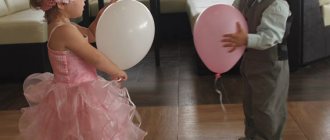One of the main natural wealth of a person is his voice, which helps not only to convey information, but also to express emotions and mood. That is why responsible parents should know the stages of child voice development and help their baby. It is important to understand the anatomical and physiological changes that occur in the larynx, respiratory organs and articulation apparatus, on which the timbre, pitch, and range of the voice depend.
Stages of formation
A person is born with a vocal apparatus that is completely ready for work, but it is necessary to teach the child how to control it, that is, to ensure that the work of the organs is coordinated by the brain.
The voice apparatus includes several parts:
- lungs;
- larynx and vocal folds - this is where sound is generated;
- a set of resonators – an articulatory apparatus.
All these parts are in constant interaction.
The stages and stages of child voice development are directly related to the baby’s growth, which is important for both parents and teachers to take into account.
It is customary to distinguish the following stages of voice development in children.
- Prenatal – begins before birth.
- Infancy – from birth to age 2.
- Early childhood age – 2-5 years.
- The average children's age is 5-9 years.
- Late childhood – from 9 years of age until puberty.
- Early adulthood – 12-15 years.
- The average adult period is 15-18 years.
- Final maturity is 19-21 years.
At each stage, there are changes in the vocal apparatus, which must be taken into account when selecting exercises for voice development.
The stages of development of the vocal apparatus are usually divided into three types:
- regular;
- intense;
- slow
They proceed in different ways, the change can be either uniform or spasmodic. In addition, stages can alternate and replace each other.
Preschoolers and primary schoolchildren have a childish voice - light and gentle. It is called falsetto or high resonance. At the same time, the vocal apparatus itself is very fragile, the sounds formed in the larynx are formed by the vibration of the ligaments, between which there is a gap; at the age of 7–8, the ligaments do not completely close. The child’s voice is still weak and high-pitched; you should not strain it too much, as hoarseness may occur.
Types of breathing
So, breathing is conventionally divided into the following types:
Clavicular or upper breathing. If you notice that your shoulders “jump” when you sing, then this is what you are using. This is the most superficial type, in which only the upper parts of the lungs are actively involved;
Thoracic or intercostal
Pay attention to your chest: it should not fall or rise while singing, but should be level. With this type of breathing, the chest expands by raising the ribs, and our main breathing muscle - the diaphragm - remains inactive;
Abdominal or diaphragmatic
This is the most complete, deep type. This is exactly what we need: we must learn to correctly use the diaphragm and abdominal muscles when singing.
Features of the voice in the first months of life
The child hears sounds and tries to reproduce them, but in the first months of life this is not always successful. The baby’s first “signals” are the cries that he makes as a reaction to internal or external stimuli. Gradually they become different in timbre, length, and height.
In the first three weeks of its life, the baby makes only three types of cry:
- from hunger;
- from pain;
- when deprived (for example, if a pacifier is taken away from him).
Then a new type appears - the cry of loneliness that a baby makes when left unattended in a crib. This is the first social signal. The early sounds that babies produce are quite simple - the vowels [a], [e], and the diphthong [əa].
It is interesting that the signals of children of this age can reveal whether they have problems.
- The cry of a healthy baby is loud, characterized by a short inhalation and a longer exhalation.
- With problems of the central nervous system, it becomes very loud, screeching, or, on the contrary, quiet, sobbing, often when inhaling.
Therefore, it is very important to listen carefully to the baby’s first sound signals. Note that babies hear the sounds made by their parents and try to repeat them, that is, the impetus for the development of speech is the development of hearing. This is why deaf babies also remain mute.
Tips for beginners
A man, a girl, a child, in general, anyone can sing, and it doesn’t matter whether he has vocal abilities or not, because beautiful singing is a skill that anyone can master. You can practice on your own or take vocal lessons from scratch with a teacher.
Whatever path you choose, we recommend that you listen to the following tips:
- Do not overstrain the ligaments, as they take a long time to recover;
- exercises must be done with short breaks;
- It’s worth mastering new exercises and techniques gradually;
- tongue twisters will help improve speech and clarity of pronunciation of words;
- You should start with 5 minutes of training a day, gradually increasing the time of training;
- You should avoid drinking alcoholic beverages and cold foods, as they have a negative impact on the vocal cords.
Stages of humming and babbling
The most important stage of the pre-speech period is humming, through which the baby communicates with his parents. Once a baby reaches 2 months of age, it begins to respond to the voices of mom and dad, so experts recommend actively communicating with it up to 6 months - this will contribute to the development of phonemic awareness. In addition, the sounds of humming are the basis for the formation of speech breathing. At this stage, the development of intonation begins.
Right now, kids are experiencing increased interest in their own voice, as if testing its capabilities. During this period, individual differences in children's voices become most noticeable.
By the third month, the babbling stage begins - the number of sounds produced gradually increases, and over time, so-called “babbling pseudowords” appear. This is a very important time for the development of preschoolers, since it includes not only voice training, but also the development of the motor and auditory reactions necessary for normal speech, as well as the ability of the articulation organs to put sounds into syllables. Unlike humming, babbling includes not only vowel sounds, but also individual consonants. The role of hearing increases - children begin to imitate both their parents and themselves. That is why in the baby’s sound environment the parents’ speech must be present, clear and correct, addressed to the children, otherwise defects and clamps, lack of intonation, even fear of one’s own voice are inevitable.
Breathing phases
In life, breathing uses only 2 phases: inhalation and exhalation. Correct breathing when singing also involves holding the air and distributing it in such a way that it is enough not only for sound formation, but also for the last phase.
Breathing phases in vocals:
- inhale;
- holding your breath;
- exhalation.
To obtain high-quality sounds, you need to work out each phase. You can do this with a teacher during vocal lessons for adults.
How to take a breath correctly
You need to take a breath through your nose and mouth. Inhalation is made silently, quickly and deeply. The ribs straighten and the diaphragm contracts. There should be no tension in the muscles.
The staging of singing breathing begins precisely with practicing the inhalation phase. Correct execution requires compliance with the following rules:
- the inhalation is active, but imperceptible, for the hearing and sight of others;
- conscious control on the part of the vocalist over the process;
- air capture follows the half-yawn principle;
- Inhalation is carried out a little earlier than phonation begins.
Holding your breath
The air is not immediately released, as when singing, but is retained in the lungs. Before a sound attack, the breathing process almost completely stops. At this moment, the diaphragm is lowered, the lower parts of the ribs are spread apart, and the front of the abdomen is ready to contract.
This phase is the moment when the inhalation unit is fixed and allows the loss of breathing to be eliminated at the initial stage.
Very often, beginning vocalists cannot cope with this particular phase. The formation of singing breathing is carried out using special breath-holding exercises.
Exhalation
Singing sounds appear precisely at this phase. Before singing begins, the upper part of the vocal apparatus must go into the form of future phonation. The lower jaw drops slightly and the pharynx opens. The most important task of the vocalist at this moment is to turn the air into sound waves. This can only be done with full control of breathing.
Exhalation should be smooth, with high-quality pressure. There should be no decrease in the singing volume of the chest. If respiratory support is not enough, then you should do another momentary air retention and only then begin vocalization.
Development from 1 to 5 years
The child begins to make meaningful sounds by the end of the 12th month of life. Listening to his parents, he gradually realizes the relationship between an object and its sound shell, therefore it is at this time that he pronounces his first simple words. By the second year of life, the baby masters questioning intonation and more clearly expresses his emotions with his voice, imitating the speech of adults.
Up to 5 years of age, problems with pronouncing individual sounds are quite possible - most often consonants, especially vibrant and hissing sounds. In most children, defects completely disappear only at 6-7 years of age.
Voice development
Parents should do everything in their power to develop their baby's hearing and voice, but they should be very careful, since excessive stress is just as harmful as complete neglect. Of particular importance is the practice of breathing, which is difficult to do independently, without musical pedagogical education. But at home, you can make a contribution as much as you can by inviting your child to perform Strelnikova’s breathing exercises, which will have a beneficial effect on the sound of the voice. Articulation gymnastics will also be useful - it will prepare the baby’s speech apparatus for the correct pronunciation of individual sounds, and will also allow you to work the muscles of the face, jaw, lips, tongue and cheeks.
Parents should remember that they can only help their child develop their voice if the following conditions are met.
- Children need a positive example, so it is extremely important that adults themselves speak correctly, emotionally, observing the necessary intonation.
- Positive emotional background. If the mother yells at the baby and gets nervous because he is unable to complete the task, then the benefits of such activities will be minimal, and the child will quickly lose interest in them. Therefore, you need to praise the baby at least for the efforts made.
- Many teachers agree that the most useful exercise for developing the voice is singing, so you can safely sing your child’s favorite songs. Music will have a beneficial effect on the ability to correctly construct phrases and pronounce sounds.
Following these simple recommendations will help you get closer to your goal.
Vocal checklist for beginners
There are many ways to analyze your breathing. We have prepared a small checklist for beginners. Try singing right now, and then answer these questions for yourself:
- Do you have enough air to sustain a long note when singing?
- Can you sing an entire phrase in one breath?
- Does your voice sound at full strength and can its timbre be determined?
- What's wrong with your shoulders - are they in place and not jumping? : )
- Are you able to control the harshness of your voice? Does it sound “soft”?
- How does your throat feel - is it okay, does it hurt?
If you answered all or some of the questions with an unequivocal “no,” then most likely your problem is improper breathing. Before we begin to work through this problem, let's look at what types of breathing generally exist.
Basic working methods
Many researchers and teachers have approached the issue of voice development in preschool children. For example, D.E. Ogorodnov suggests stimulating not just the development of a child’s vocal cords, but also his emotional and speech abilities, and the ability to perceive shape. The technique completely denies falsetto sound, recognizing it as inferior. It allows you to develop flexibility, timbre and a large number of intonations, but makes it difficult to move into a high register. During such activities, the children's voices changed, and in addition, there was variability in the pronunciation of vowels. The voice developed downward, because Ogorodnov considered high sounds unsightly.
Emelyanov's program has the opposite direction. It is called “Phonopedic method of voice development” and is aimed at the formation of singing voice formation and the development of the vocal apparatus.
Such exercises are divided into several levels.
- Preparatory. Work with various types of vocal activity (squeaking, wheezing, screaming, wheezing, moaning).
- Development of academic singing voice. Work is underway to improve mastery of intonation, emotional and phonemic hearing.
- Formation of academic singing tone. At this stage, the uneven development of the vocal apparatus is eliminated, and preparation for changes in the puberty period occurs.
Another technique is to write music specifically for children, allowing them to develop their vocal abilities.
How to breathe correctly when singing
In singing, any particular type of breathing is never used in isolation; a mixed or combined version is more common. This means that the standard vocalist must be able to breathe as he needs here and now, have freedom of breathing in the same way as a dancer has freedom of movement
An important difference between singing breathing and speaking breathing is the length of exhalation: the vocalist needs a powerful air flow, and this imposes certain requirements on the quality of inhalation
The inhalation should be quick, capacious and silent. A noisy inhalation spoils the performance, a slow one wastes time, a weak one does not provide a sufficient volume of air. Inhalation is followed by a short breath hold. The exhalation should be strong, long, the throat should be as open as possible, the larynx should be lowered
It is important to be able to stretch your air reserves and not lose the strength of exhalation at the same time.
Voice development exercises for children
Let's look at some effective exercises that parents can adopt. First of all, these are speech games; there are quite a lot of them.
- Listening to fairy tales with your child that use pre-speech communicative elements (noises, squeals, squeaks, squeaks).
- Reading poetry in different registers - it will be easier for the child if you ask him to recite the poem the way a bear (chest register) and a hedgehog (falsetto) would do it.
- When the previous exercise begins to work out without problems, you can complicate it a little by moving from the falsetto register to the chest register in one quatrain.
- You can learn to change the pitch of your voice with this exercise. Depict a picture with your voice while simultaneously “drawing” in the air with your hand. The higher the hand moves, the higher the voice becomes. In this way you can, for example, depict a tall spruce.
- Elevator ride. The child pronounces a sound, simultaneously moves his hand up and down (simulating the movement of an elevator car), and accordingly changes the timbre of his voice.
- Vocal mobility improves singing with your mouth closed.
- This game will help develop the ability to speak louder. The parent invites the child to call the bear for tea. But the bear doesn’t hear, he’s far away, you need to call him louder. It is important to ensure that children do not scream, but rather speak more loudly.
- Another game is the opposite, the baby’s task is to speak quietly so as not to wake up the bear. But it is necessary not to switch to a whisper, but to make the voice quieter.
- Further the task becomes more complicated. The parent selects paired toys, for example, cars, large and small. Then he asks the child to imitate what sound a big car makes (it should be loud). The small one, on the contrary, beeps quietly. Then the situation is repeated with the second pair of toys. The baby must learn to quickly and correctly change the volume of his voice.
- This game will help develop the ability to speak in a “thin” and low voice: the mother asks the child to depict what sounds a cat makes and what sounds a kitten makes. In the second case, the child should pronounce “meow” lower than in the first. The situation with birds plays out in a similar way.
- You can read the fairy tale “The Three Bears” to your child, and then ask him to convey the peculiarities of the speech of each of the characters: Mikhail Ivanovich has a rough, low voice, Nastasya Potapovna’s voice is a little lower, and Mishutka speaks in a ringing, high-pitched voice.
- It will be interesting for boys to imitate driving a car that drives along the road, then goes around a puddle, rushes over bumps. Then the task changes - driving a big car is replaced by driving a small one.
Such games will bring real pleasure to your child if they are played in a light, unobtrusive manner. In addition, they are very useful for improving the functioning of the vocal apparatus, especially the larynx. Gradually, a positive result will be noticeable - children will learn to express emotions in speech, use sounds of different strengths and pitches, and speech defects, on the contrary, will become less obvious.








